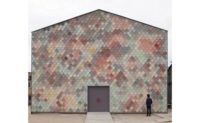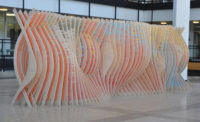When presented with a design challenge, the London architecture practice Studio Weave doesn’t hesitate to scribble outside the lines—way outside of them. For a beachside promenade, the firm devised a curlicuing 1,000-foot-long bench. When presented with a pile of 15,000 LEGOS for a London Festival of Architecture competition, it constructed a mini metropolis complete with a tiny monorail. Within the firm’s online portfolio, work is presented through both standard project factoids and original fairy tales.
Whimsy may be a hallmark of Studio Weave’s built work, but the firm addresses serious questions concerning how people engage with their surroundings and neighbors, particularly in London, where construction cranes are rising as rapidly as rents.
“The professional role of an architect is to design according to a brief,” says Studio Weave founder Je Ahn, “but, as citizens, we also have duties.”
Studio Weave’s offices are located in the city’s Hackney area in a formerly industrial building, complete with an impressive trussed roof and a foosball table. One afternoon last spring, the firm’s 10 members—referred to internally as “Weavers”—were busy at work on their biggest project to date, a multimillion-dollar, 250-unit social-housing complex in central London, a huge scaling up from the firm’s previous work. “I was always interested in how people lived,” says Ahn, describing his initial interest in architecture. “Coming from a culturally different place—South Korea—architecture’s impact on how we behave was fascinating to me.”
The studio was founded in 2006 by Ahn and Maria Smith while both were studying architecture at London Metropolitan University. (Smith has since left the firm.) Called 140 Boomerangs, their first collaboration consisted of modular timber components which could be configured to create site-specific helical structures. First displayed at the London Architecture Biennale (now called the London Festival of Architecture) 140 Boomerangs was used to hold workshops for local children. The project was so successful, commissions—including the seaside bench in Littlehampton, England—followed. It made sense to officially establish a practice.
In 2012, the studio won a competition to improve an unsightly facade of the Great Ormond Street Hospital for children. With their sense of playfulness, Studio Weave added pipework as well as gramophone-like horns to create a surreal 10-story landscape they dubbed the Lullaby Factory. A calming soundtrack by composer Jessica Curry can be heard by patients through a selection of “listening pipes” and a special radio frequency. The project won numerous awards, including an AR+D Award for emerging architecture.
“We try to get under the skin of the commission,” explains Ahn of the firm’s outlook. “Often, an architectural proposal is only part of the answer.”
A prime example of this approach is an ongoing regeneration project in the small town of Callan, Ireland, where the main thoroughfare had become a civic dead zone because of heavy traffic. Starting in 2014, Studio Weave worked with the municipality on a series of temporary street closures, staging pop-up events and children’s activities. Last year, they worked with locals to spruce up facades and make the street an interactive theater. According to a local reporter, the festival gave the town “a morale boost that any town or village in Ireland would welcome.”
Last June, Studio Weave and London firm Architecture 00 joined forces to create “Project 00,” a consortium of architects, social scientists, programmers, and urban planners. The studio is also part of a Royal Institute of British Architects (RIBA) exhibition about the future of housing, working on a woodland classroom for special-needs children, and wrapping up a project for the Crown Estate in central London.
“We are not experts at anything,” says Ahn, “but we try to get the best out of a situation by linking the right people together.”


















